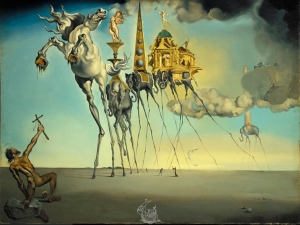The Temptation of St. Anthony (Dalí)
The Temptation of St. Anthony is a painting by the Spanish surrealist artist Salvador Dalí. Completed in 1946, this artwork is a notable example of Dalí's mature period, where he perfected his technique of combining surrealism with religious themes. The painting depicts the story of Saint Anthony the Great, the Christian monk and hermit from Egypt, who faced a series of temptations during his sojourn in the desert.
Description[edit | edit source]
The painting features a desolate, desert landscape, a hallmark of Dalí's surrealist environments, which serves as the backdrop for the narrative. In the foreground, Saint Anthony is seen as a small, almost insignificant figure, standing with his arms outstretched in a gesture of resistance against the temptations that confront him. The temptations are personified by a procession of elephants, which are depicted in a dream-like state, carrying on their backs symbols of wealth, power, and erotic desire. These elephants are rendered with long, spindly legs, suggesting a fragility and instability that contrasts with their traditional symbolism of strength and memory.
The most striking element of the painting is the use of surrealism to depict the elephants. Dalí employs the technique of the "paranoiac-critical method," a process he developed to tap into the subconscious and bring forth dream imagery onto the canvas. This method is evident in the distorted proportions and the dream-like atmosphere that pervades the scene.
Themes and Interpretations[edit | edit source]
The Temptation of St. Anthony explores themes of temptation, purity, and resilience. Dalí's depiction of the saint's resistance against the lures of earthly pleasures and power is a vivid illustration of the spiritual trials that individuals face. The painting can be interpreted as a reflection on the human condition, highlighting the constant struggle between moral integrity and the allure of material and sensual temptations.
The choice of Saint Anthony as the subject also reflects Dalí's interest in the mystical and the religious. Throughout his career, Dalí was fascinated by religious themes and figures, often reinterpreting biblical stories and characters with his unique surrealist vision. The Temptation of St. Anthony is a prime example of this aspect of his work, blending religious iconography with surreal imagery to create a deeply symbolic and thought-provoking piece.
Provenance and Legacy[edit | edit source]
Since its completion, The Temptation of St. Anthony has been exhibited in various galleries and museums around the world. It is celebrated as one of Dalí's masterpieces and a key work in the canon of 20th-century art. The painting is not only a testament to Dalí's skill as a painter but also to his ability to infuse traditional themes with a modern, surreal twist.
The painting has inspired numerous interpretations and analyses, contributing to the rich body of scholarship on Dalí's work. It remains a subject of fascination for art historians, scholars, and enthusiasts, who continue to explore its complex symbolism and its place within the broader context of surrealist art.
See Also[edit | edit source]
Search WikiMD
Ad.Tired of being Overweight? Try W8MD's physician weight loss program.
Semaglutide (Ozempic / Wegovy and Tirzepatide (Mounjaro / Zepbound) available.
Advertise on WikiMD
|
WikiMD's Wellness Encyclopedia |
| Let Food Be Thy Medicine Medicine Thy Food - Hippocrates |
Translate this page: - East Asian
中文,
日本,
한국어,
South Asian
हिन्दी,
தமிழ்,
తెలుగు,
Urdu,
ಕನ್ನಡ,
Southeast Asian
Indonesian,
Vietnamese,
Thai,
မြန်မာဘာသာ,
বাংলা
European
español,
Deutsch,
français,
Greek,
português do Brasil,
polski,
română,
русский,
Nederlands,
norsk,
svenska,
suomi,
Italian
Middle Eastern & African
عربى,
Turkish,
Persian,
Hebrew,
Afrikaans,
isiZulu,
Kiswahili,
Other
Bulgarian,
Hungarian,
Czech,
Swedish,
മലയാളം,
मराठी,
ਪੰਜਾਬੀ,
ગુજરાતી,
Portuguese,
Ukrainian
Medical Disclaimer: WikiMD is not a substitute for professional medical advice. The information on WikiMD is provided as an information resource only, may be incorrect, outdated or misleading, and is not to be used or relied on for any diagnostic or treatment purposes. Please consult your health care provider before making any healthcare decisions or for guidance about a specific medical condition. WikiMD expressly disclaims responsibility, and shall have no liability, for any damages, loss, injury, or liability whatsoever suffered as a result of your reliance on the information contained in this site. By visiting this site you agree to the foregoing terms and conditions, which may from time to time be changed or supplemented by WikiMD. If you do not agree to the foregoing terms and conditions, you should not enter or use this site. See full disclaimer.
Credits:Most images are courtesy of Wikimedia commons, and templates Wikipedia, licensed under CC BY SA or similar.
Contributors: Prab R. Tumpati, MD

